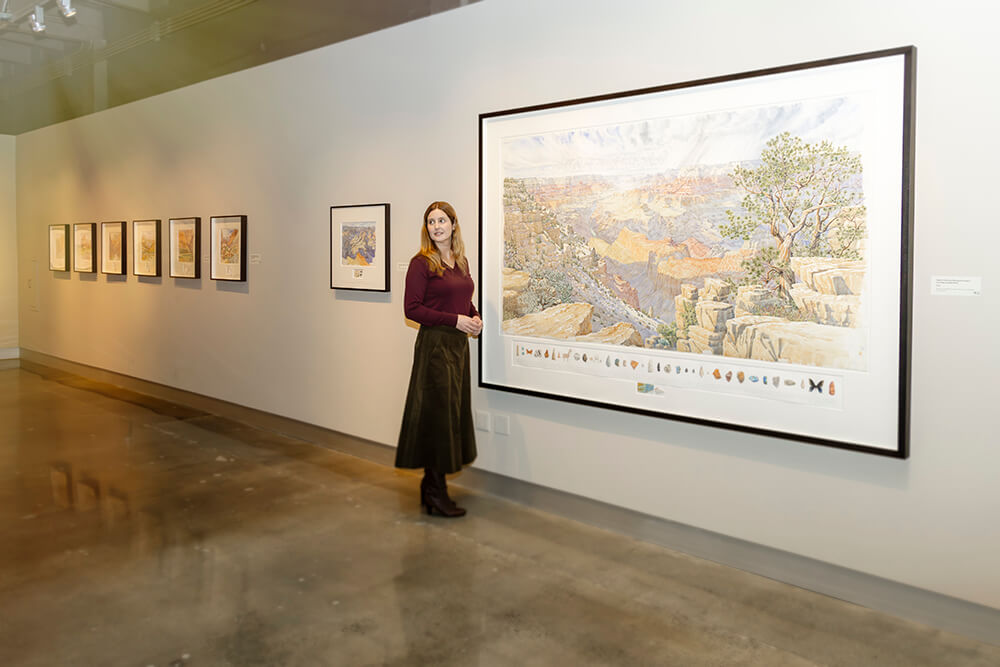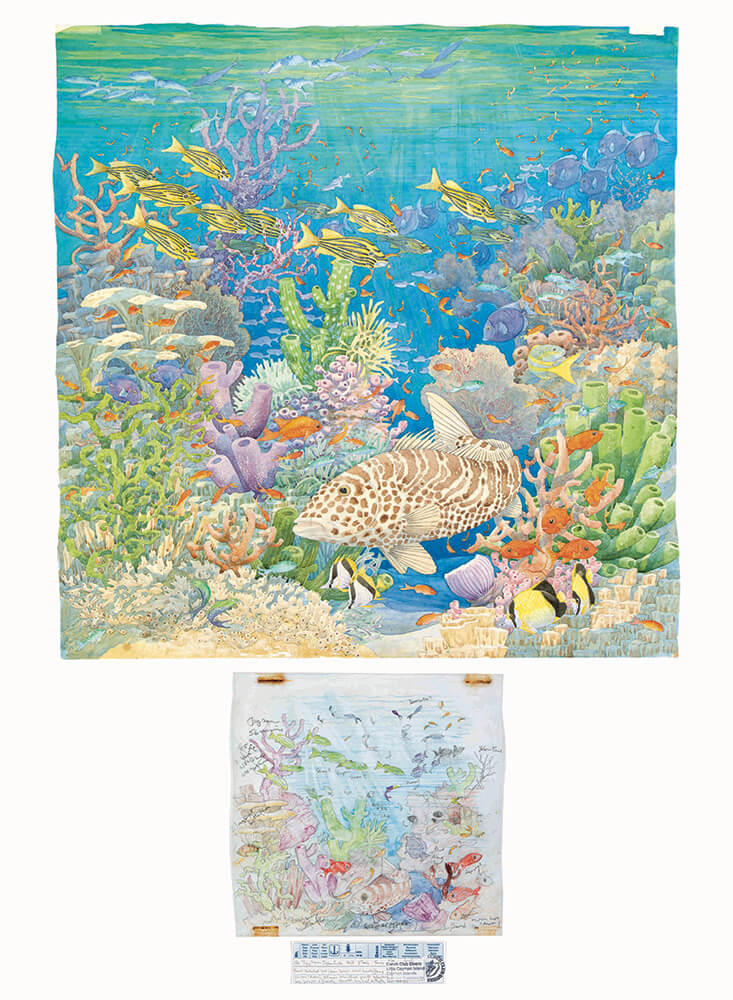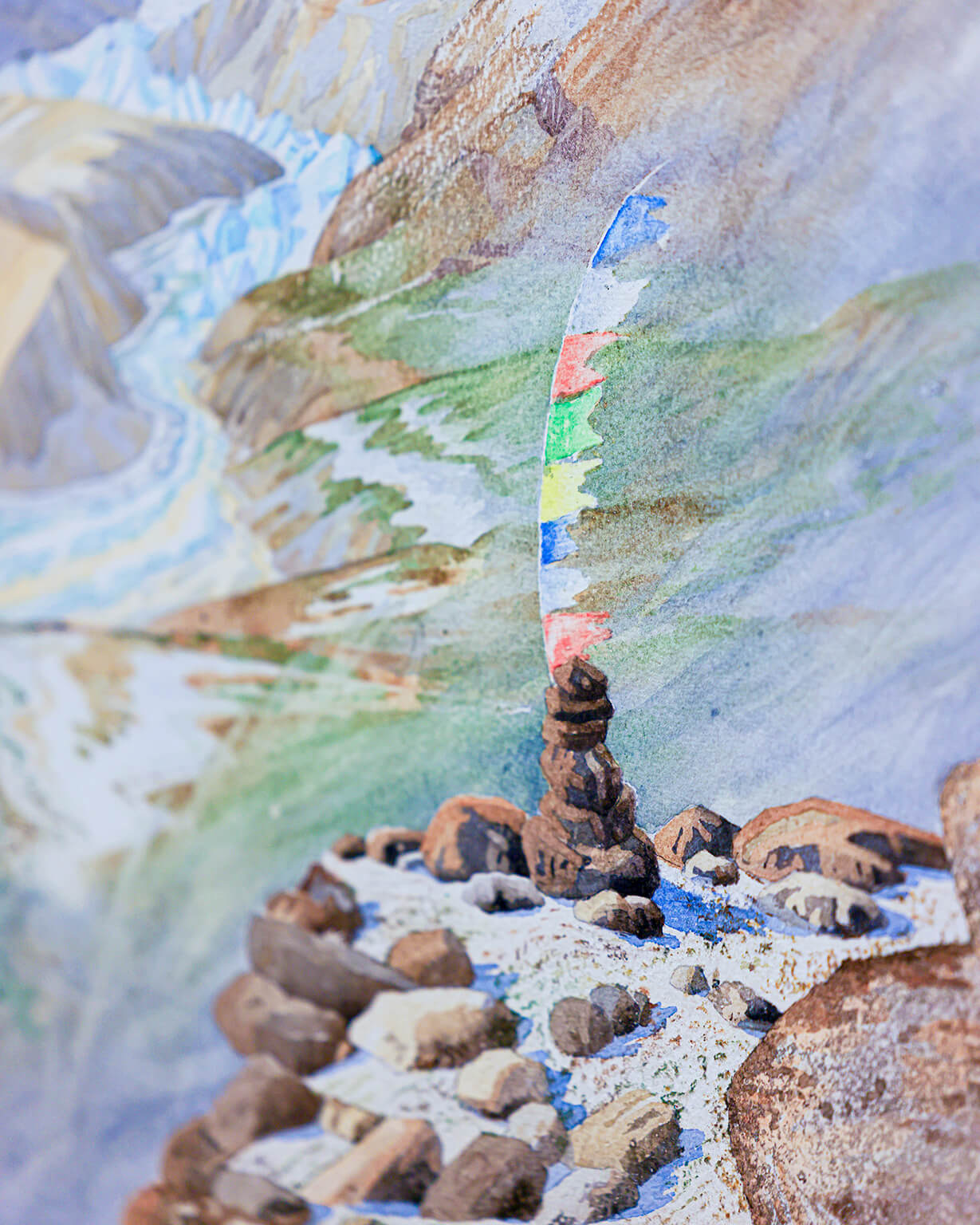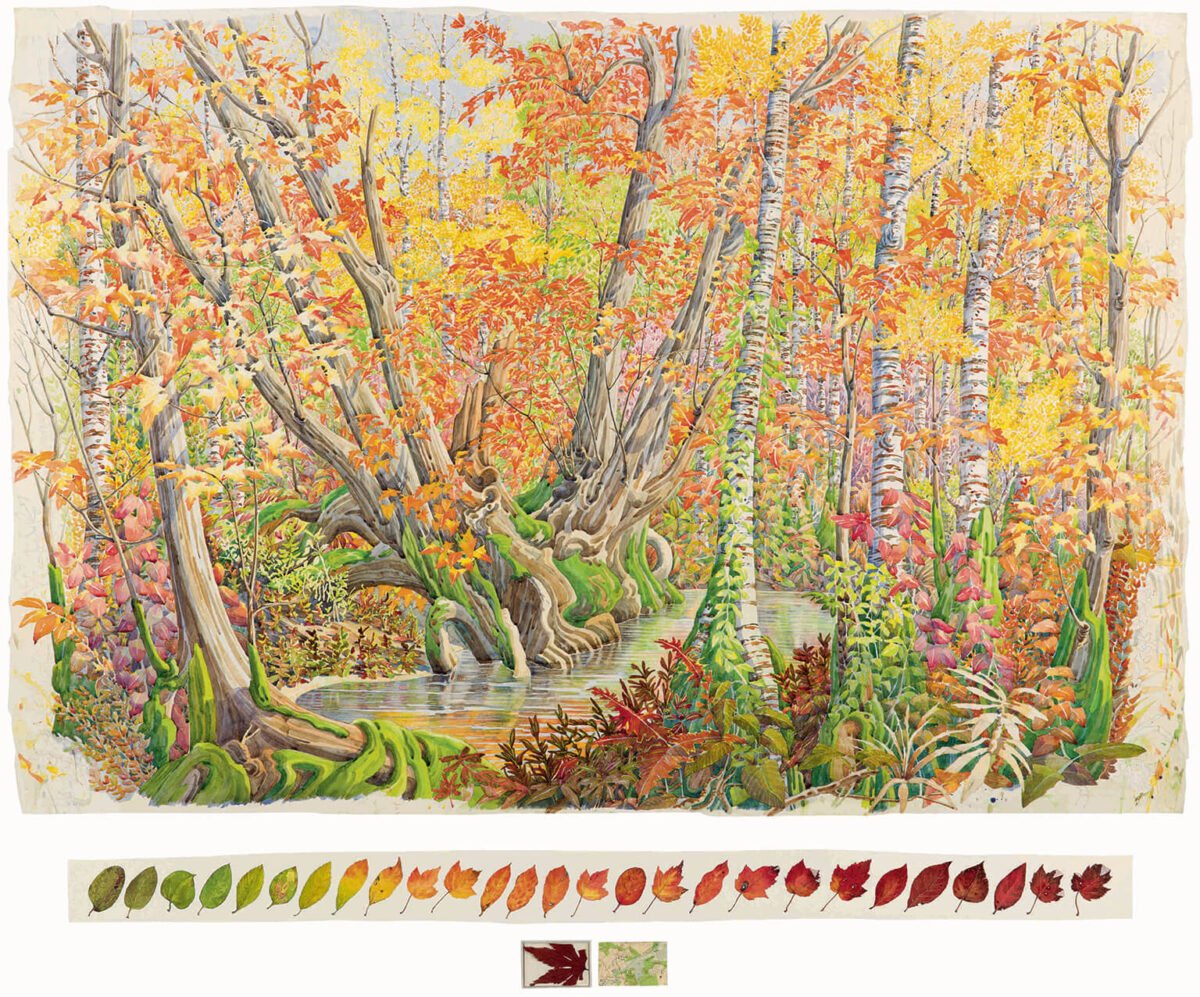Words by Andrea Gemmet
If you ask Alisa Eagleston-Cieslewicz to name her favorite painting at The Foster Museum in Palo Alto, there’s no hesitation. It’s Fall Colour, part of British artist Tony Foster’s series of watercolor works called Exploring Beauty. “I love how it captures the beautiful colors of fall. I think that autumn trees are exceptionally beautiful,” she says. When the California native was earning a master’s degree in art history at New York University, she was stunned by the sheer magnitude of the East Coast’s fall display. “One of my favorite things about living in New York was how Central Park became this amazing wash of different reds and oranges and yellows.”
The vibrant landscape, like many of Tony’s plein air watercolor paintings, includes a bit of bonus material at the bottom—in this case a color-coded row of detailed paintings of different leaves. “I think Tony captures that variety of color and the intensity of it so well,” says Alisa, who admits to being “one of those people” who love autumn. “I also really love the individual leaves at the bottom of the work, because I think the larger landscape at the top … captures the overall feel of the season and of the color. But those individual leaves show you the building blocks for that overall impression.”
Alisa, the new executive director of The Foster, has been drawn to art since she was a precocious preschooler fascinated by the expressive works of the Rodin Sculpture Garden at Stanford University. Alisa traces her career path back to Stanford’s Cantor Art Center, which she often explored with her alumni parents. Later, as a Stanford undergraduate, Alisa joined the museum crew and helped maintain that same collection of Rodin statues.

Fast-forward to internships at the Metropolitan Museum of Art in New York and the De Young Museum in San Francisco, a contract job with the SF Fine Arts Museums, an MBA from UC Berkeley. Most recently, Alisa served as the acting director of the SFO Museum, where she held various roles for 16 years, before landing at The Foster in October.
The peaceful vibe of The Foster Museum couldn’t be more different from San Francisco International, which has the nation’s only accredited museum in an airport. There, the luggage-toting visitors are more likely to be rushing past the museum exhibits than to pause in quiet reflection while waiting for their planes. From weather delays to construction work, “something is always happening at the airport,” Alisa laughs. The Foster, a large, vine-covered building incongruously located off of busy San Antonio Road, is an oasis of contemplative calm by comparison.
Solely dedicated to the work of Tony Foster, the eponymous museum houses a beautifully displayed collection of his watercolor landscapes that celebrate some of earth’s most wild, beautiful—and usually hard-to-reach—locations. Tony documents his artistic journeys, some taking years to complete, in a series of paintings large and small, accompanied by handwritten journal entries, sketches made in the field and small “souvenirs” (like dried leaves, shells, rocks) from the site.
The Foster Museum boasts a broad overview of Tony’s artistic output, called “Journeys,” from his first one in 1982, following Robert Louis Stevenson’s 1879 path through France, called Travels without a Donkey in the Cévennes. The collection includes Rainforest Diaries from Costa Rica and views of volcanoes with Ice and Fire in the 1990s to more recent journeys: Secret Sites in Idaho, Sacred Places in the American Southwest and the globe-spanning Exploring Beauty.

“I think one of the really wonderful things is that The Foster Museum has free admission. This is for everyone,” says Alisa. “It’s a resource for anybody who wants to come experience it, enjoy it, learn from it.” She walks through a gallery of works from the Exploring Beauty series and exclaims, “Oh, I have to show you the fish!” She explains that Tony solicited recommendations for the most beautiful places from notable scientists, explorers, writers and environmentalists. Sir David Attenborough’s chosen location sent Tony to a reef in the Cayman Islands.
An underwater photo shows the artist at work, suited up in scuba gear and sketching with pencils on a sheet of plastic instead of his usual sketchpad. While he normally makes his watercolors in situ, Tony relied on those waterproof sketches to recreate the multicolored wonderland of fish and corals he witnessed in a large-scale painting done on dry land. “That’s so challenging, because watercolors are obviously not going to work underwater,” Alisa notes.
At The Foster, Tony’s lovely pictures serve as an invitation for viewers to connect with nature and think about the need to protect these wonderful wild places. Opposite his luminous reef painting is a table set with coloring sheets on clipboards, a tray of seashells, colored pencils, a magnifying glass and laminated photos of sea creatures, an opportunity for young viewers to create underwater scenes of their own. Community outreach is a priority at The Foster, Alisa says, serving both its mission of environmental stewardship and acknowledging its out-of-the-way location.
Alisa has long been interested in conservation of a different kind. She started out as a conservator, with a vital behind-the-scenes role caring for objects in museum collections, doing everything from polishing antique silver to repainting damaged porcelain. Over the years, she’s worked on Greek and Roman antiquities and restored a damaged 1950s scale model of a United Airlines DC-8, fabricating replacements for a slew of missing hands, feet and accessories for the plane’s diminutive passengers and crew. She says conservators might spend an entire day up close and personal with a single object. “It allowed me to interact with artworks in a way I really love,” Alisa shares.

For someone with a conservation background, having ready access to the artist for questions about how to preserve their work is a boon. Not only is Tony transparent about his materials and methods—his palm-sized paint box, hiking boots and collection of paintbrushes are on display in The Foster—there’s no need to speculate when he’s just a phone call away. Alisa notes that a few of his paintings include marginalia, like an image of Chaco Canyon in New Mexico from Sacred Places. “These works are just so beautiful,” Alisa says, and then points out a series of small, quick brushstrokes outside the picture’s margins where Tony tested various colors in search of the right one.
It’s clear Alisa relishes being part of her hometown community, where she’s also the chair of Palo Alto’s Historic Resources Board. “It’s a really wonderful time to be coming to this museum because the museum is so new,” she says of The Foster, which opened in 2016. After a pandemic closure, it’s definitely starting to hit its stride, she adds. “Being from Palo Alto, it’s a very special thing to be able to be a part of an institution like this, that can really reach out to the community, and can serve as a place of education and as a gathering place.”
She notes the positive messages transmitted by Tony’s work: slowing down, taking a closer look at beautiful places around the world and cultivating the desire to preserve them. “I think those are really powerful concepts,” Alisa reflects, “and I’m really looking forward to helping people engage with them.”
The Foster Museum in Palo Alto hosts children’s story times, public lectures and events like nature journaling and art making. Go to thefoster.org for more information or a free reservation.


